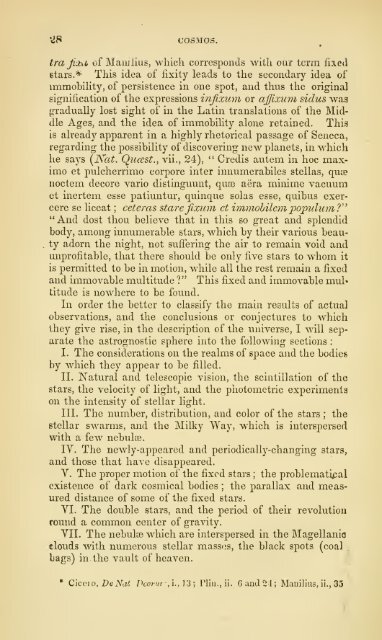See the complete document here
See the complete document here
See the complete document here
- No tags were found...
You also want an ePaper? Increase the reach of your titles
YUMPU automatically turns print PDFs into web optimized ePapers that Google loves.
V}8 COSMOS.*tra jijtxLof Manilius, which corresponds with our term fixed6tars> This idea of fixity leads to <strong>the</strong> secondary idea ofimmobiHty, of persistence in one spot, and thus <strong>the</strong> originalsignification of <strong>the</strong> expressions injixum or ajjixum sidus waagradually lost sight of in <strong>the</strong> Latin translations of <strong>the</strong> MiddleAges, and <strong>the</strong> idea of immohihty alone retained. Thisis already apparent in a highly rhetorical passage of Seneca,regarding <strong>the</strong> possibility of discovering new planets, in which" Credis autem in hoc max-he says (JXcit. Quccst., vii., 24),imo et pulcherrimo corpore inter innumerabiles stcllas, qua?nocteiTi decore vario distinguunt, qua3 aera minime vacuumet mertem esse patiuntur, quinque solas esse, quibus exercerese liceat ;ceteras stare Jixuni ct iimnohilcm 'po'puliunV'"And dost thou believe that in this so great and splendidbody, among innumerable stars, which by <strong>the</strong>ir various beautyadorn <strong>the</strong> night, not sufiering <strong>the</strong> air to remain void andfive stars to whom itunprofitable, that <strong>the</strong>re should be onlyispermitted to be in motion, while all <strong>the</strong> rest remain a fixedand immovable multitude ?" This fixed and immovable mul*titude is now<strong>here</strong> to be found.In order <strong>the</strong> better to classify <strong>the</strong> main results of actualobservations, and <strong>the</strong> conclusions or conjectures to which<strong>the</strong>y give rise, in <strong>the</strong> descrij)tion of <strong>the</strong> universe, I will separate<strong>the</strong> astrognostic sp<strong>here</strong> into <strong>the</strong> following sections :I. The considerations on <strong>the</strong> realms of space aiid <strong>the</strong> bodiesby which <strong>the</strong>y appear to be filled.II. Natural and telescopic vision, <strong>the</strong> scintillation of <strong>the</strong>stars, <strong>the</strong> velocity of light, and <strong>the</strong> photometric experimentson <strong>the</strong> intensity of stellar light.III. The number, distribution, and color of <strong>the</strong> stars ;<strong>the</strong>stellar swarms, and <strong>the</strong> Milky Way, which is interspersedwith a few nebulse.lY. The newly-appeared and periodically-changing stars,and those that have disappeared.V. The proper motion of <strong>the</strong> fixed stars ;<strong>the</strong> problematij3alexistence of dark cosmical bodies ;<strong>the</strong> parallax and measureddistance of some of <strong>the</strong> fixed stars.VI . The double stars, and <strong>the</strong> period of <strong>the</strong>ir revolutionround a common center of gravity.VII. The nebulse which are interspersed in <strong>the</strong> Magellaniaclouds with numerous stellar mass(js, <strong>the</strong> black spots (coallags) in <strong>the</strong> vault of heaven.• Cicei o, X>eiVa^ /Vorvr i. •, J3 ; Pliii., ii. 6 and 21 ; Mauillas, ii., 35
















